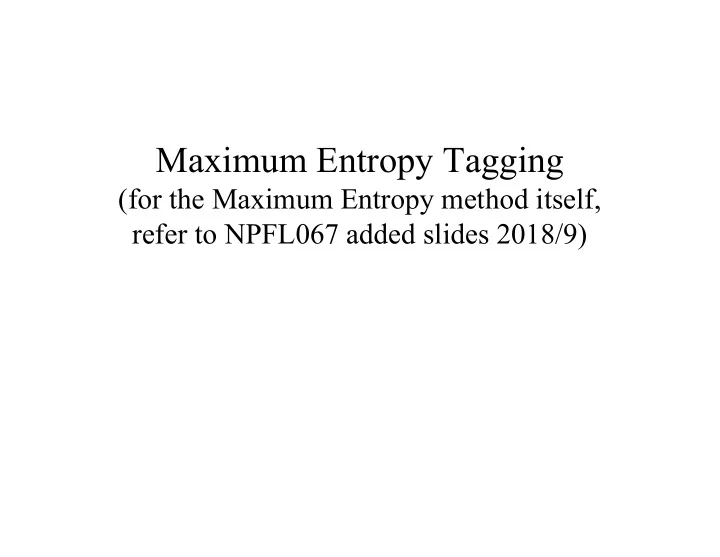

Maximum Entropy Tagging (for the Maximum Entropy method itself, refer to NPFL067 added slides 2018/9)
The Task, Again • Recall: – tagging ~ morphological disambiguation – tagset V T (C 1 ,C 2 ,...C n ) • C i - morphological categories, such as POS, NUMBER, CASE, PERSON, TENSE, GENDER, ... – mapping w {t V T } exists • restriction of Morphological Analysis: A + 2 (L,C1,C2,...,Cn) where A is the language alphabet, L is the set of lemmas – extension to punctuation, sentence boundaries (treated as words) 2018/2019 UFAL MFF UK NPFL068/Intro to statistical NLP II/Jan Hajic and Pavel Pecina 49
Maximum Entropy Tagging Model • General p(y,x) = (1/Z) e i=1..N i f i (y,x) Task: find i satisfying the model and constraints • E p (f i (y,x)) = d i where • d i = E’(f i (y,x)) (empirical expectation i.e. feature frequency) • Tagging p(t,x) = (1/Z) e i=1..N i f i (t,x) ( 0 might be extra: cf. in AR) • t Tagset, • x ~ context (words and tags alike; say, up to three positions R/L) 2018/2019 UFAL MFF UK NPFL068/Intro to statistical NLP II/Jan Hajic and Pavel Pecina 50
Features for Tagging • Context definition – two words back and ahead, two tags back, current word: • x i = (w i-2 ,t i-2 ,w i-1 ,t i-1 ,w i ,w i+1 ,w i+2 ) – features may ask any information from this window • e.g.: – previous tag is DT – previous two tags are PRP$ and MD, and the following word is “be” – current word is “an” – suffix of current word is “ing” • do not forget: feature also contains t i , the current tag: – feature #45: suffix of current word is “ing” & the tag is VBG f 45 = 1 2018/2019 UFAL MFF UK NPFL068/Intro to statistical NLP II/Jan Hajic and Pavel Pecina 51
Feature Selection • The PC 1 way (see also yesterday’s class): – (try to) test all possible feature combinations • features may overlap, or be redundant; also, general or specific - impossible to select manually – greedy selection: • add one feature at a time, test if (good) improvement: – keep if yes, return to the pool of features if not – even this is costly, unless some shortcuts are made • see Berger & DPs for details • The other way: – use some heuristic to limit the number of features • 1 Politically (or, Probabilistically-stochastically) Correct 2018/2019 UFAL MFF UK NPFL068/Intro to statistical NLP II/Jan Hajic and Pavel Pecina 52
Limiting the Number of Features • Always do (regardless whether you’re PC or not): – use contexts which appear in the training data (lossless selection) • More or less PC, but entails huge savings (in the number of features to estimate i weights for): – use features appearing only L-times in the data (L ~ 10) – use w i -derived features which appear with rare words only – do not use all combinations of context (this is even “LC 1 ”) – but then, use all of them, and compute the i only once using the Generalized Iterative Scaling algorithm • 1 Linguistically Correct 2018/2019 UFAL MFF UK NPFL068/Intro to statistical NLP II/Jan Hajic and Pavel Pecina 53
Feature Examples (Context) • From A. Ratnaparkhi (EMNLP, 1996, UPenn) – t i = T, w i = X (frequency c > 4): • t i = VBG, w i = selling – t i = T, w i contains uppercase char (rare): • t i = NNP, tolower(w i ) w i – t i = T, t i-1 = Y, t i-2 = X: • t i = VBP, t i-2 = PRP, t i-1 = RB • Other examples of possible features: – t i = T, t j is X, where j is the closest left position where Y • t i = VBZ, t j = NN, Y t j {NNP, NNS, NN} 2018/2019 UFAL MFF UK NPFL068/Intro to statistical NLP II/Jan Hajic and Pavel Pecina 54
Feature Examples (Lexical/Unknown) • From AR: – t i = T, suffix(w i )= X (length X < 5): • t i = JJ, suffix(w i ) = eled (traveled, leveled, ....) – t i = T, prefix(w i )= X (length X < 5): • t i = JJ, prefix(w i ) = well- (well-done, well-received,...) – t i = T, w i contains hyphen: • t i = JJ, ‘-’ in w i (open-minded, short-sighted,...) • Other possibility, for example: – t i = T, w i contains X: • t i = NounPl, w i contains umlaut (ä,ö,ü) (Wörter, Länge,...) 2018/2019 UFAL MFF UK NPFL068/Intro to statistical NLP II/Jan Hajic and Pavel Pecina 55
“Specialized” Word-based Features • List of words with most errors (WSJ, Penn Treebank): – about, that, more, up, ... • Add “specialized”, detailed features: – t i = T, w i = X, t i-1 = Y, t i-2 = Z: • t i = IN, w i = about, t i-1 = NNS, t i-2 = DT – possible only for relatively high-frequency words • Slightly better results (also, problems with inconsistent [test] data) 2018/2019 UFAL MFF UK NPFL068/Intro to statistical NLP II/Jan Hajic and Pavel Pecina 56
Maximum Entropy Tagging: Results • Base experiment (133k words, < 3% unknown): – 96.31% word accuracy • Specialized features added: – 96.49% word accuracy • Consistent subset (training + test) – 97.04% word accuracy (97.13% w/specialized features) • Best in 2000; for details, see the AR paper • Now: perceptron, ~97.4% – Collins 2002, Raab 2009 2018/2019 UFAL MFF UK NPFL068/Intro to statistical NLP II/Jan Hajic and Pavel Pecina 57
Recommend
More recommend